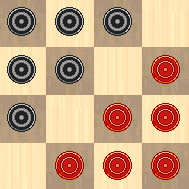

Introduction
To win in Halma you must be the first to move all your counters from their starting positions in your yard into the opponent’s yard. Players take turns, moving a single counter at a time. A counter may move in one of two ways:
1) It may shift to an adjacent square horizontally, vertically, or diagonally, or
2) It may leap over an adjacent counter (of either color) to the opposite, unoccupied square. The counter leapt over is not captured. A leaping counter may continue to leap over other counters until there are no more to leap over or the player decides to stop.
Note that in all these new versions of Halma it is not allowable to jump or step backwards (i.e. in the direction of one’s own yard). In the above picture it would mean that the red pieces are not allowed to move east, south, or south-east.
Traditional Halma is a simple draw, since neither side is forced to move all its counters out of its starting position. In this version, if a counter in its home position can make progress outward by jumping an enemy counter it must do so (a rule invented by S. Sackson).
Since a counter which has just jumped can continue jumping, you should try to form ‘ladders’ of jumpable counters to more quickly get your counters down the board. Try to avoid that the opponent can jump via your own counters.
These variants have been invented by me (Dec 2005) and are inspired by the Halma variant Grasshopper. Original Halma, (the big 16 square version) was invented in 1883 by the Harvard Medical School surgeon,George Howard Monks. Original Halma caught on in England, and to some extent in Germany, but otherwise hasn’t had much success, although it became the favorite game of the last Empress of Russia, Alexandra Feodorovna. The word ‘Halma’ comes from the Greek word for ‘leap’.
Discussion
Halma, which is the predecessor of Chinese Checkers, is attractive because of its moderate complexity and simplicity of rules. What also speaks to its advantage is that it is void of war-like characteristics, contrary to most other board games where one “kills” the opponent’s pieces, one way or another.
But the original 16x16 Halma is rather slow when played by only two persons, because it takes such time to mobilize the forces on the huge board. For two persons, it is probably better to play this game on smaller boards, i.e. a chess or checkers board, or on a division of the chess, checkers, Halma, or Go board. (In China and Japan they often use a division of the big 19x19 Go board for other games, such as certain 5-in-a-row games.)
To this end backward moves and jumps are disallowed, so that obstructive moves cannot be made. This new rule makes even the smallest 4x4 board playable and quite interesting. Backward moves are useless anyway, and although backward jumps sometimes can be useful, it only improves the game to disallow them because the game becomes less confusing and easier to control without such moves. Furthermore, the computer programs play the game better without backward moves because it keeps pushing the pieces towards the goal, as there is no other choice.
The following 14 variants with different board sizes and number of counters have been implemented: 4x4 (6 counters), 5x5 (6 counters), 6x6 (6 counters), 7x7 (6 counters), 7x7 (10 counters), 8x8 (6 counters), 8x8 (10 counters), 8x8 (15 counters), 9x9 (6 counters), 9x9 (10 counters), 9x9 (15 counters), 10x10 (6 counters), 10x10 (10 counters), 10x10 (15 counters).
Quite surprisingly, the 4x4 version (see image above) is a difficult little game. This proves that Halma implemented on these small boards is a quite competitive game variant. It is hard to master this little game, and a minor lapse of white will give the advantage to black.
© Mats Winther 2005
You can download my free ‘Halma variants’ program here (updated Dec 7, 2005), but you must own the software Zillions of Games to be able to run it.